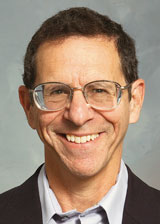Volume 26 · Number 4 · Summer 2009
Letters
Prout, Matloff and Stebbins

Norm Matloff
I very much enjoyed the Spring 2009 edition featuring three professors who had a major influence on my doctoral career at UC Davis. Sadly, the edition featured the obituary of my major professor, Tim Prout, who was an inspirational and caring mentor. Tim’s loss has been a blow to many of us who worked or studied with him. [He had a] global influence on the field of evolutionary biology. It also featured the work of Norm Matloff, who examined me in statistics during my oral examinations in 1982, and who is now fighting for the rights of domestic computer science graduates. Since my older son is pursuing a degree in computer science, I say, “Thanks Norm!” Finally I was delighted by your piece on the Stebbins Cold Canyon reserve. . . . G. Ledyard Stebbins, one of the fathers of the modern synthesis of evolutionary theory, was still teaching doctoral courses at UC Davis during my Ph.D. years (1980–85) and was guest lecturing in undergraduate courses as well. One memorable day during my second year at UC Davis, I was the teaching assistant for the undergraduate course in evolution. Professor Stebbins was scheduled to be a guest lecturer while the regular faculty member was out of town — but he was late to class. We began to worry, but he showed up, bruised, scraped up, and needing to sit down throughout the lecture. Apparently that morning he had taken a group of grad students on a botanizing hike in the Sierra foothills. He’d gotten way ahead of the students (despite being at least three times their ages!) and had slipped and fallen a fair distance down the hill before they stopped his fall. Despite his injuries, he gave an excellent lecture to the assembled class, without ever going to the chalkboard or referring to any notes.
, Ph.D. ’85
SENCER Leadership Fellow,
Dean of Science and Technology,
College of Staten Island of CUNY
Horace Hampton

Horace Hampton
Reading your story about Horace Hampton, “A Presidential President” in the spring issue, brought back a lot of good memories. “Hamp” and I were both residents of North Hall in the years 1948 through ’50. (Page 28 of that issue has a vintage picture long before our time there). He was a very special guy and, being older than most of us, had a lot of stories and wisdom to share. When he was elected student body president, we were a proud bunch of Aggies!
But there is another story to tell about Hamp, one we all liked to brag about: Hamp was the only one I ever knew who could smoke his often-present cigar and take a shower at the same time!
Don Barr ’50
Spyridakis Indeed
Jean Jasper Edward’s article [“Co-ed Finally Bares All,” Spring 2009] captured the emotion of the ’72–’76 years at UC Davis wonderfully! I was there, in 194 Chem, the day that a streaker struck Professor Spyridakis’ class. Those in the class will also remember the day that students plotted his “# of ‘indeeds’/day” and placed it on a 20-foot banner at the front of the class. He was one of my most memorable and inspirational professors of the day.
Gerald Mitchell ’76
Obese not disabled
I would like to respond to [comments by] Judith Stern [“Informed Dissent,” spring 2009]. Obesity is not a disease. Obesity is by choice — an abundance of food and lack of exercise. We cannot have a disease that we knowingly brought onto ourselves and continue to exacerbate, while blaming it on society. . . . Obesity should be not classified as a disability because it is a very rectifiable problem, albeit one that might take significantly longer to get rid of than the common cold.
Hai Yang Yu ’07
MMA Risks
Although I am very impressed with the athleticism and accomplishments of Urijah Faber in mixed martial arts, I am more concerned that the [spring 2009] article about his participation in the sport gives credibility to mixed martial arts (MMA). As a physician, I would like to remind the editors that a blow to the head can lead to severe injuries. The medical associations of various countries, including the U.S., recommend that MMA and boxing be banned. MMA is popular, is in the news, but it still is a violent sport with long-term injuries suffered by the athletes.
Kevin Miller ’98
More on campus gender gap
With two children (one male, one female) in college, I read articles like “Sexx Shift” [Winter 2009] with a great deal of interest in the statistics and underlying causes of the gender shift in undergraduate enrollment. Many such articles are amusing to me as they often have an overall tone of dismay that works only one way, i.e., great concern that there are so many more women in college now. Well, what’s wrong with that? Was there the same level of worry when the percentages were reversed? . . . [The article states that] “in 1979 . . . women overtook men in undergraduate enrollment.” Good to hear, after hundreds of years of denying education to half the population. This makes sense for many of the socioeconomic reasons mentioned in the article, although there is no mention of what could also be a contributing reason for men’s decline in enrollment at the same time: The Vietnam war ended in 1975, and many young men were no longer enrolling in college as a way to avoid the draft. So whose approach to education changed, that of the women or that of the men? . . . I was a college graduate in the 1970’s and, like many women, I experienced discrimination and bias — not only in college, but in the workforce and society in general in the years since. Ask Hillary Clinton about that glass ceiling. Ask Lilly Ledbetter about equal pay for equal work. As women of my age know, discrimination may be declining but it’s still there; it’s just a whole lot more subtle.
Liz Allan, San Mateo
In your spring ’09 issue you published two flames from women unhappy with your winter ’09 article “Sexx Shift.” I especially loved Ms. Jadwin’s comment about how
“. . . the boys should be striving to emulate girls’ strategies for success.” I remember that comment from back in those turbulent days of the 60’s and 70’s! Only then it was why didn’t women and minorities emulate the strategies of successful white men? It was as ignorant and offensive then as it is now. . . . Why is it so reprehensible that schools and universities could now have the audacity to show a modest amount of concern with the pendulum having swung so dramatically the other way in women’s favor? I mean, there are schools that haven’t had a male valedictorian in 10 years. In my day, there were two parts to the SAT: the verbal, on which the girls, nationally, did better than the boys, and the math, on which the boys, nationally, did better than the girls. Now, there is a written section also. . . . It skews the test towards the girls.
William Best, J.D. ’92
While the gender gap is certainly a story of both interest and importance, I feel that the article lacked a critical cultural perspective and was rife with sexist stereotypes. . . . [The article, citing a Student Housing official, described an increase in] all-female floors and said “there’s been a corresponding increase in roommate conflicts, with more blow-ups likely among women over things like room décor and borrowing clothes.” Room decor and borrowing clothes?! . . . You might as well have said, “Women are catty and fight over petty, stupid things.” What could possibly be the purpose of including this statement? In the future if you are writing an article on cultural issues, it might be helpful to consult people in the cultural studies departments. In the meantime, I will try not to be too embarrassed that the institution from which I recently graduated is presenting such an offensive article as factual and newsworthy.
Kristine Vandenberg ’07
